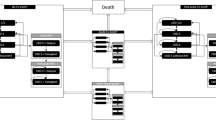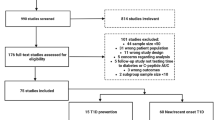Abstract
Objective
Teplizumab was recently shown to be the first-ever drug to prevent or delay type 1 diabetes mellitus onset in at-risk individuals, especially those with certain genetic and antibody characteristics. However, its potentially high price may pose challenges for coverage and reimbursement for payers and policymakers. Thus, it is critical to investigate the cost effectiveness of this drug for different target individuals.
Research Design and Methods
Using Markov microsimulation modeling, we compared the cost effectiveness of five options for choosing target individuals (i.e., all at-risk individuals, individuals without human leukocyte antigen (HLA)-DR3 or with HLA-DR4 allele, individuals without HLA-DR3 and with HLA-DR4 allele, individuals with anti-zinc transporter 8 (ZnT8) antibody negative, and no provision at all) at different possible prices of teplizumab. Effectiveness was measured by quality-adjusted life-years. Costs were estimated from a health system perspective.
Results
If the price of teplizumab is below US$48,900, treating all at-risk individuals is cost effective. However, it will be cost effective to treat only individuals without HLA-DR3 or with HLA-DR4 alleles for prices between US$48,900 and US$58,200, only individuals both without HLA-DR3 and with HLA-DR4 alleles for prices between US$58,200 and US$88,300, and only individuals with negative ZnT8 antibody status for prices between US$88,300 and US$193,700.
Conclusions
Cost-effective provision of teplizumab to target individuals depends on the price of teplizumab and genetic and antibody characteristics of treated individuals. As the drug makes its way to the market, findings from this study will help inform policymakers and payers on cost-effective ways to provide this innovative but expensive drug to at-risk individuals.


Similar content being viewed by others
References
Klinke DJ. Extent of beta cell destruction is important but insufficient to predict the onset of type 1 diabetes mellitus. PLoS One [Internet]. 2008;pp. 3. https://www.ncbi.nlm.nih.gov/pmc/articles/PMC2147725/. Accessed 21 Dec 2019.
Statistics About Diabetes|ADA [Internet]. 2019. https://www.diabetes.org/resources/statistics/statistics-about-diabetes. Accessed 21 Nov 2019.
Chiang JL, Kirkman MS, Laffel LM, Peters AL. Type 1 diabetes through the life span: a position statement of the American Diabetes Association. Diabetes care. 2014;37:2034–54.
Tao B, Pietropaolo M, Atkinson M, Schatz D, Taylor D. Estimating the cost of type 1 diabetes in the US: a propensity score matching method. PLoS One. 2010;5:e11501.
Hua X, Carvalho N, Tew M, Huang ES, Herman WH, Clarke P. Expenditures and prices of antihyperglycemic medications in the United States: 2002-2013. Jama. 2016;315:1400–2.
Families Cross Borders in Search for Affordable Insulin [Internet]. 2019. https://www.webmd.com/diabetes/news/20190718/spiking-insulin-costs-put-patients-in-brutal-bind. Accessed 21 Nov 2019.
Diabetes and insulin costs: Diabetics struggle as drug prices soar [Internet]. 2019. https://www.usatoday.com/in-depth/news/50-states/2019/03/21/diabetes-insulin-costs-diabetics-drug-prices-increase/3196757002/. Accessed 21 Nov 2019.
Herold KC, Bundy BN, Long SA, Bluestone JA, DiMeglio LA, Dufort MJ, et al. An anti-CD3 antibody, teplizumab, in relatives at risk for type 1 diabetes. N Engl J Med. 2019;381:603–13.
Dolgin E. Anti-CD3 drug keeps diabetes at bay. Nature Biotechnol. 2019;37:1099.
Provention Bio Announces PRV-031 (Teplizumab) granted PRIME designation by the European Medicines Agency [Internet]. 2019. https://www.prnewswire.com/news-releases/provention-bio-announces-prv-031-teplizumab-granted-prime-designation-by-the-european-medicines-agency-300944591.html. Accessed 21 Nov 2019.
Reuters. Experimental drug delays type 1 diabetes onset in mid-stage trial [Internet]. Reuters. 2019. https://www.reuters.com/article/us-health-diabetes-tepzlizumab-idUSKCN1TA0P8. Accessed 1 Jan 2020.
Craig A-M, Kennedy L. Health economic considerations for early drug discovery [Internet]. 2019. https://www.ddw-online.com/drug-discovery/p148533-health-economic-considerations-for-early-drug-discovery.html. Accessed 21 Dec 2019.
Ijzerman MJ, Koffijberg H, Fenwick E, Krahn M. Emerging use of early health technology assessment in medical product development: a scoping review of the literature. Pharmacoeconomics. 2017;35:727–40.
Thokala P, Kruger J, Brennan A, Basarir H, Duenas A, Pandor A, et al. Assessing the cost-effectiveness of Type 1 diabetes interventions: the Sheffield Type 1 diabetes policy model. Diabetic Medicine. 2014;31:477–86.
TreeAge Software. TreeAge Pro 2019, R1 [Internet]. 2020. https://www.treeage.com/software-downloads/treeage-pro-2019-r1/. Accessed 17 Aug 2020.
US Census Bureau. National Population by Characteristics: 2010-2018 [Internet]. The United States Census Bureau. 2019. https://www.census.gov/data/tables/time-series/demo/popest/2010s-national-detail.html. Accessed 21 Dec 2019.
WebPlotDigitizer v4.2 [Internet]. 2019. https://automeris.io/WebPlotDigitizer/. Accessed 21 Dec 2019.
Guyot P, Ades AE, Ouwens MJ, Welton NJ. Enhanced secondary analysis of survival data: reconstructing the data from published Kaplan-Meier survival curves. BMC Med Res Methodol. 2012;12:9.
Diaby V, Adunlin G, Montero AJ. Survival modeling for the estimation of transition probabilities in model-based economic evaluations in the absence of individual patient data: a tutorial. Pharmacoeconomics. 2014;32:101–8.
Haines P, Tremblay G, Briggs A. A criterion-based approach for the systematic and transparent extrapolation of clinical trial survival data. J Health Econ Outcomes Res. 2015;2:147–60.
Centers for Disease Control and Prevention. US Life Tables [Internet]. 2019. https://www.cdc.gov/nchs/products/life_tables.htm. Accessed 21 Dec 2019.
Centers for Medicare and Medicaid Services. Clinical laboratory fee schedule files [Internet]. 2019. https://www.cms.gov/Medicare/Medicare-Fee-for-Service-Payment/ClinicalLabFeeSched/Clinical-Laboratory-Fee-Schedule-Files. Accessed 21 Dec 2019.
Dall TM, Yang W, Gillespie K, Mocarski M, Byrne E, Cintina I, et al. The economic burden of elevated blood glucose levels in 2017: diagnosed and undiagnosed diabetes, gestational diabetes, and prediabetes. Diabetes Care. 2019;2019:dc181226.
GoodSmith MS, Skandari MR, Huang ES, Naylor RN. The impact of biomarker screening and cascade genetic testing on the cost-effectiveness of MODY genetic testing. Diabetes Care. 2019;42:2247–55.
US Bureau of Labor Statistics. CPI Inflation Calculator [Internet]. 2020. https://www.bls.gov/data/inflation_calculator.htm. Accessed 17 Aug 2020.
NICE. Guide to the methods of technology appraisal 2013|guidance and guidelines [Internet]. 2013. https://www.nice.org.uk/process/pmg9/chapter/foreword. Accessed 14 Oct 2018.
Makrilakis K, Liatis S, Tsiakou A, Stathi C, Papachristoforou E, Perrea D, et al. Comparison of health-related quality of Life (HRQOL) among patients with pre-diabetes, diabetes and normal glucose tolerance, using the 15D-HRQOL questionnaire in Greece: the DEPLAN study. BMC Endocrine Disord. 2018;18:32.
Rhodes ET, Goran MI, Lieu TA, Lustig RH, Prosser LA, Songer TJ, et al. Health-related quality of life in adolescents with or at risk for type 2 diabetes mellitus. J Pediatr [Internet]. 2012;160:911–7. https://www.ncbi.nlm.nih.gov/pmc/articles/PMC4793715/. Accessed 21 Jul 2020.
Lee JM, Rhee K, O’Grady MJ, Basu A, Winn A, John P, et al. Health utilities for children and adults with type 1 diabetes. Medical Care. 2011;49:924 (NIH Public Access).
Wan W, Skandari MR, Minc A, Nathan AG, Winn A, Zarei P, et al. Cost-effectiveness of continuous glucose monitoring for adults with type 1 diabetes compared with self-monitoring of blood glucose: the DIAMOND randomized trial. Diabetes Care Am Diabetes Assoc. 2018;41:1227–34.
Neumann PJ, Cohen JT, Weinstein MC. Updating cost-effectiveness—the curious resilience of the $50,000-per-QALY threshold. N Engl J Med. 2014;371:796–7.
Briggs A, Sculpher M, Claxton K. Decision modelling for health economic evaluation. OUP Oxford; 2006.
Miquel-Cases A, Retèl VP, van Harten WH, Steuten LM. Decisions on further research for predictive biomarkers of high-dose alkylating chemotherapy in triple-negative breast cancer: a value of information analysis. Value Health. 2016;19:419–30 (Elsevier).
Canadian Agency for Drugs and Technologies in Health (CADTH). Guidelines for the Economic Evaluation of Health Technologies: Canada. CADTH; 2017 [Internet]. 2017. https://www.cadth.ca/sites/default/files/pdf/economic_guidelines_worked_example.pdf.
Vemer P, Corro Ramos I, van Voorn GAK, Al MJ, Feenstra TL. AdViSHE: a validation-assessment tool of health-economic models for decision makers and model users. pharmacoeconomics [Internet]. 2016;34:349–61. http://link.springer.com/10.1007/s40273-015-0327-2. Accessed 17 Aug 2020.
Eddy DM, Hollingworth W, Caro JJ, Tsevat J, McDonald KM, Wong JB. Model transparency and validation: a report of the ISPOR-SMDM Modeling Good Research Practices Task Force–7. Medical Decision Making. Sage Publications Sage CA: Los Angeles 2012;32:733–43.
Diabetes Prevention Trial–Type 1 Diabetes Study Group. Effects of insulin in relatives of patients with type 1 diabetes mellitus. N Engl J Med. Mass Medical Soc 2002;346:1685–91.
Mayer-Davis EJ, Lawrence JM, Dabelea D, Divers J, Isom S, Dolan L, et al. Incidence trends of type 1 and type 2 diabetes among youths, 2002–2012. N Engl J Med. Mass Medical Soc 2017;376:1419–29.
Patented Medicine Prices Review Board. PMPRB steering committee on modernization of price review process guidelines—final report [Internet]. 2019. http://pmprb-cepmb.gc.ca. Accessed 23 Dec 2019.
Johnson SR, Carter HE, Leo P, Hollingworth SA, Davis EA, Jones TW, et al. Cost-effectiveness analysis of routine screening using massively parallel sequencing for maturity-onset diabetes of the young in a pediatric diabetes cohort: reduced health system costs and improved patient quality of life. Diabetes Care. 2019;42:69–76.
Hägg-Holmberg S, Thorn LM, Forsblom CM, Gordin D, Elonen N, Harjutsalo V, et al. Prognosis and its predictors after incident stroke in patients with type 1 diabetes. Diabetes Care. Am Diabetes Assoc. 2017;40:1394–400.
Brophy S, Cooksey R, Gravenor MB, Weston C, Macey SM, John G, et al. Population based absolute and relative survival to 1 year of people with diabetes following a myocardial infarction: a cohort study using hospital admissions data. BMC Public Health. Springer 2010;10:338.
Author information
Authors and Affiliations
Corresponding author
Ethics declarations
Funding
No funding was received for this study.
Conflicts of Interest
Authors have no conflicts of interest to disclose.
Ethics approval
This was a modelling study and did not require ethics approval.
Availability of data and material
All data inputs used to parameterize the model are available within the article and the Online Supplementary Materials. Description of the decision tree component of the model is provided in the article. The microsimulation component is adapted from the Sheffield Type 1 Diabetes Policy Model which is described in a previously published article: Thokala et al. “Assessing the cost-effectiveness of Type 1 diabetes interventions: the Sheffield Type 1 Diabetes Policy Model.” Diabetic Medicine 31.4 (2014): 477-486. The model was built based on these model descriptions and data inputs.
Code availability
The model was built in TreeAge Pro software, which does not require user-specified codes.
Consent to participate
Not applicable.
Consent for publication
Not applicable.
Author contributions
SM conceptualized the idea. Both SM and HVN contributed to data analysis, interpretation of results and manuscript writing.
Electronic supplementary material
Below is the link to the electronic supplementary material.
Rights and permissions
About this article
Cite this article
Mital, S., Nguyen, H.V. Cost Effectiveness of Teplizumab for Prevention of Type 1 Diabetes Among Different Target Patient Groups. PharmacoEconomics 38, 1359–1372 (2020). https://doi.org/10.1007/s40273-020-00962-y
Accepted:
Published:
Issue Date:
DOI: https://doi.org/10.1007/s40273-020-00962-y




